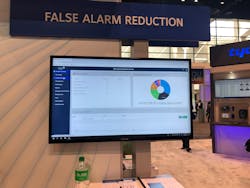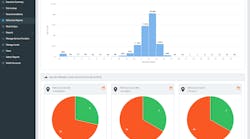CHICAGO - While alarms and monitoring generally takes a back seat to video surveillance, access control and other technologies at GSX, handling the ongoing false alarm issues that tend to plague the industry was still being discussed in Chicago.
I caught up with Julie Beach, VP of Sonitrol, in the Stanley Security booth at GSX (#903) to discuss how false alarms can be curbed in commercial security markets, and then saw a demo of an innovative false alarm reduction software at the nearby Johnson Controls booth.
“There are techniques outside of just audio and video verification and we need to be looking at those as well,” said Beach, whose Sonitrol franchises are known for criminal apprehension as a result of verified commercial alarms. “If somebody has a high rate of false alarms, you need to be out there doing something to help your customer to figure out why - not waiting until they come waving a $500 false alarm fine and blame you.”
Beach added: “Security companies do have a responsibility that if we're seeing high false alarm rates at certain locations, we should be doing something about it. A lot of times it is just placement of something or making sure that the door contacts are secure or those kinds of things. A lot of false alarm reduction can take place through proactive management of your customers.”
Interestingly, just adjacent to my conversation with Sonitrol, Johnson Controls was touting its False Alarm Reduction Service – a standalone web application that analyzes alarm data from an intrusion system and uses machine learning to provide recommendations on how to reduce false alarms and site risk.
“The fact of the matter is, (false alarms) are an issue – it has been an issue for a while, we all share it, and we have to own up to that,” JCI VP of Marketing Hank Monaco told me. “Oftentimes as an integrator, we don’t want to put the onus on our customers (to stop the alarms), so machine learning can help us understand some of the root causes for false alarms. We are able to help folks materially reduce them, and not only save them money, but also save them time, promote a better safety culture and do a better job at partnering with law enforcement.”
While first introduced earlier this year at ISC West, the False Alarm Reduction Service is available to both integrators and JCI end-user customers. It can be deployed as a cloud solution or as an on-premise solution. It does not need any hardware and can be accessed by any web-enabled device.
I was able to watch a demo of the product, which produced sample reports outlining a wide variety of potential false alarm triggers at a fictional facility. It displayed the data at first in a single snapshot with recommendations and potential root causes for the alarms. The recommendations are produced by proprietary machine learning algorithms identified and list actions the user needs to take to reduce that alarm from happening in the future.
The fictional company had 89 false alarms because of a stale call tree, for instance. The software also can calculate ROI by assigning a dollar value to each false dispatch event – that, for example, cost the company $100 each, thus creating nearly $9,000 in immediate savings by remedying that one problem.
You can see the demos of the product for yourself in Johnson Controls booth #703 at today’s final expo day at GSX. Catch up with Sonitrol in the Stanley booth, #903.
Paul Rothman is Editor-in-Chief of Security Business magazine. Pick up a free copy at booth #1929 at GSX, or visit www.securitybusinessmag.com.





